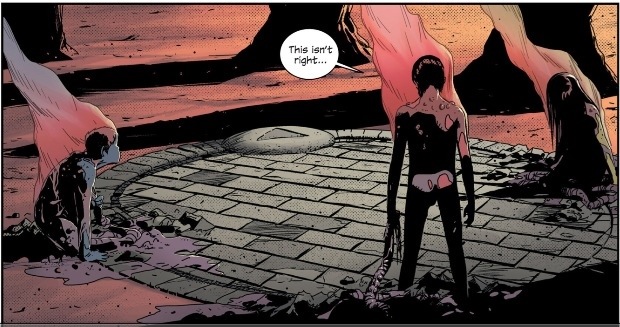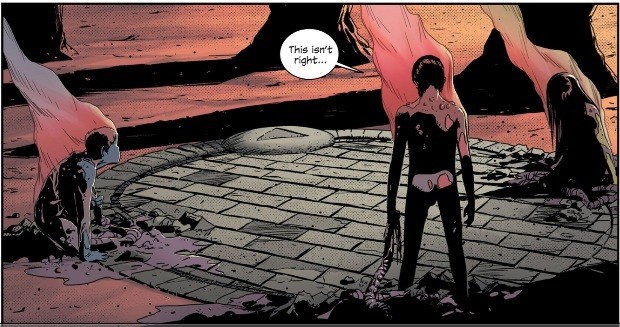This is the world. It’s not the one we were supposed to have, but it’s the one we made.
We did this. We did it with open eyes and willing hands. We broke it, and there is no putting it back together.
East of West is not an easy comic to pin into any one genre – visually a Space Western, tonally a spiritual end-of-days scenario, and a politically-charged alternate history of the United States. Although the storyline takes place in 2064, it is in a world where events differ from the 1860s onwards. The Seven Nations of Americas are united in the hatred that they have for each other, living in an endless Civil War, against which the Four Horsemen of the Apocalypse try to track down the President, living in The White Tower, a huge complex. Something has separated the Four though – three have been reborn as pre-pubescent children, each embodying their own traits in both appearance and attitude. Famine is a skeletal, sickly yellow young girl, Conquest a stocky boy who constantly refers to humans as “parasites” and “cattle”, and War, a skinny brooding boy coloured red. Death has failed to come back with them.

The back-story of how the world has come to be this way is succinct, but occasionally a little hard to follow. A combination of prophecy and divine intervention lead us to now, when a completely pale man walks into The Atlas with his Native American back-up who are stylistically monochromatic so as to put them at visual odds with the Union in gritty uniforms. When his tall friend Wolf is threatened, a bloodbath ensues, most of it only seen in the horror of the bartender’s eyes as he watches his friends being mutilated while the white man stands and calmly drinks. The technological equipment employed in the Western setting reminded me of Akira, and other cyberpunk texts.
2064 is the first year of the apocalypse, and the Three Horsemen are preparing. Shifting piles of corpses and taunting survivors in ways that reveal the effect living in a young body has had on them, they laugh about how funny it is when humans try to hug them only to pull back nubs. It’s revealed that the children are piling the corpses into the giant pyramid symbol which is reflected in much of the iconography of the book, especially in terms of the united prophecies. The end of the world is coming, and it has something to do with the events of the Civil War.
At the White Tower, the White Man approaches the President in his office. One of the beautiful things about this comic is the detail in the backgrounds: beside his desk we can see an altered version of the Stars and Stripes flag featuring thirteen stars in a circle. The White Man reveals that the President took something from him, and did something worse to him than dying, and in a fantastic set of panels he takes on the appearance of Otis from House of 1000 Corpses, wildly shouting with long white hair flying out behind him, a merciless look on his face.
Hickman is clearly playing a long game with the story, so nothing is too clear right now. Thematically, this story is concerned with our current obsession with end-of-days scenarios, whether through financial collapse, the destruction of the environment, scientific advances and spiritual retribution. From the Y2K virus scare, we have lived through the 6/6/6, the Mayan calender ending, economic crises, and the use of the Large Hadron Collider. But this comic isn’t as bleak as it might seem right now – according to Hickman there will be hope, and love, in the middle of all this destruction and anger. He also deals with the corruption of government, and makes it so natural for the President and the most important people in the Seven Nations to be evil liars.
The artwork by Dragotta is something special, who is so skilled at the subtlest details (like The Crow’s habit of taking eyes). The backgrounds often have cartoonish blood and ink spatters and the characters feel very distinctive already at the end of this issue, and I really want to see how the children grow up – although for now very much enjoying their Children of the Corn feel. Hickman has promised that a love story will develop, as well as the deepening revenge tale, all with a core concept – that the things that divide us are stronger than the things that unite us. From the Fantastic Four duo Jonathan Hickman and Nick Dragotta, after selling out almost instantly, issue one will receive a second release on the same day as the second issue, April 24th, from Image Comics.
Originally posted on the Travelling Man blog
